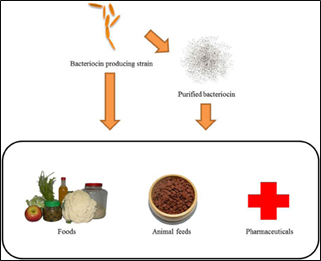Authors: Ajay Kumar*, Deepak Kumar, Aman Jaiswal, Shekhar Kumar
Division of Microbiology, ICAR-Indian Agricultural Research Institute, New Delhi (India) 110 012
*Corresponding author e-mail: jangraajay8888@gmail.com
What are bacteriocins?
- Bacteriocins are ribosomally synthesised antimicrobial peptides or complex proteins secreted by various Gram-positive and Gram-negative bacteria
- The structure of this toxin usually resembles the shape of a protein or peptide. It consists of amino acid chains of different size.
- Bacteriocins were first discovered by Andre Gratia in 1925.
- He called his first discovery a colicine because it killed E. coli.
- Bacteriocin name was proposed by Jacob et al. (1952) for the group of highly specific antibiotic like substances produced by certain strains of the bacteria which are active against other strains.
Specific properties of bacteriocins
- Molecular weight of bacteriocins ranges from 2 kDa to 300 kDa.
- Have both narrow and broad inhibitory spectrum of activities.
- Active against the homologous species.
- Have an essential, biologically active protein moiety.
- Have a bactericidal mode of action.
- There is attachment to specific cell receptors.
- Genetic determinants for bacteriocin production are plasmid-borne.
Microbes that produce bacteriocins
| Microbes | Bacteriocin |
| Bacillus | Coagulin, Lichenin |
| Enterococcus | Enterocin |
| Lactobacillus | Lactocin |
| Lactococcus Leuconostoc | Nisin Leucocin A, Carnocin |
| Pediococcus | Pediocin |
| Streptococcus | Bovicin HC5 |

Applications of bacteriocins
- Alcoholic beverages
- Baby foods
- Bakery products
- Clinical application
- Disinfectants
- Protection of fresh fruit, vegetable, and sauces
Alcoholic beverages
- Prevent the development of food spoilage bacteria
- High shelf stability without affecting flavour and aroma of beer.
- Decrease of sulphurous anhydride levels in wine
Bakery products
- Bacteriocin at low concentration (14 AU/gm) is effective against vegetative cells ofB. subtilis, B. licheniformis, B. cereus, and B. pumilus strains under experimental conditions, while its higher concentration (23 AU/gm) is required in killing of endospores .
- S. aureus inhibition was also observed with addition of AS48 in liquid caramel, pumpkin comfiture or diluted almond cream.
- Bacteriocin prevents ropiness in bread and enterotoxins production in various desserts including baker cream, soy-based desserts, and gelatin puddings.
Baby foods
- Campylobacter is one of the leading bacterial causes of foodborne illness.
- Use of antibiotics may lead to developing resistance that will cause sickness in human consumers.
- Spray-dried bacteriocin lacticin 3147 powder has effective antimicrobial activity and can be used in a range of foodstuffs like infant milk, powdered soup, yoghurt, and cottage cheese (Ross and Hill, 2004).
Protection of fresh fruit, vegetable and sauces
- Inactivate L. monocytogenes in fruits.
- Complete inactivation of S. aureus in sauces at conc. 80mg/ml.
- Inactivation of the Geobacillus stearothermophilus in coconut milk and coconut wate.r and rope forming Bacillus licheniformis LMG 19409 in fresh made apple juices.
As disinfectants
- Main use of disinfectants are on hospital surfaces, dairy and food industry.
- The bacteriocin molecules which are stable to drying, water rinsing, freezing, and have long stability profile, attached to the surface or article which can later on interact with susceptible bacteria deposited on the treated surface and kill the microorganisms.
Clinical applications
- Lantibiotics- Treatment of Blood pressure, Inflammations and allergies, Skin infections, Mastitis infections, Herpes, Dental carries, Peptic ulcer
- Colicins- Treatment of Haemolytic uremic syndrome, urogenital infection, Haemorrhagic colitis.
- Microcins- Antimicrobial agent, Salmonellosis treatment
- Cotter PD, Ross RP, Hill C (2013). Bacteriocins—a viable alternative to antibiotics. Nat Rev Microbiol 11: 95–105
- Okuda K, Zendo T, Sugimoto S, Iwase T, Tajima A, Yamada S, Sonomoto K, Mizunoe Y (2013). Effects of bacteriocins on methicillin-resistant Staphylocococcus aureus biofilm. Antimicrob Agents Chemother 57: 5572-5579.
- van Heel AJ, Montalban-Lopez M, Kuipers OP (2011). Evaluating the feasibility of lantibiotics as an alternative therapy against bacterial infections in humans. Expert Opin Drug Metab Toxicol 7: 675–680.
- Reis JA, Paula AT, Casarotti SN, Penna ALB (2012). Lactic acid bacteria antimicrobial compounds: characteristics and applications. Food Eng Rev 4:124–140.
About Author / Additional Info:
I am pursuing PhD in department of microbiology from Indian Agricultural Research Institute, New Delhi-110012